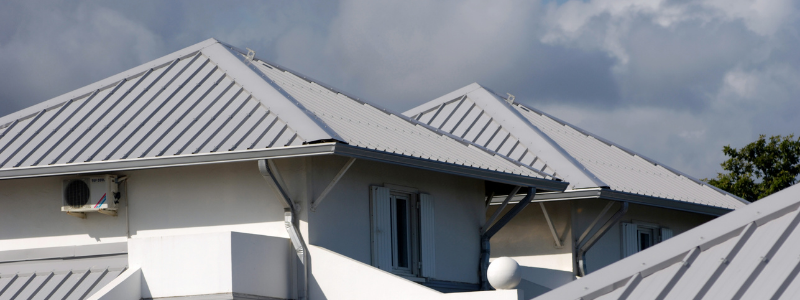Is a Leaking Roof an Emergency?
Unfortunately, many home and business owners at one point find themselves asking: is a leaking roof an emergency?
Here’s the short answer: No matter how big or small a leaking roof might seem – it’s an emergency.
If you would like to get in contact with an expert immediately, we offer 24/7 emergency roof repair.
A small leak can soon develop into a big problem and a big leak can quickly lead to a lot of water damage in your home.
If you have a leaky roof, you may not need to replace the entire roof. Sometimes, a combination of smaller repairs and preventative maintenance can stop you from having problems in the future. Here are some things to look out for if you are experiencing a leaky roof and ways you can help prevent leaks in the future.
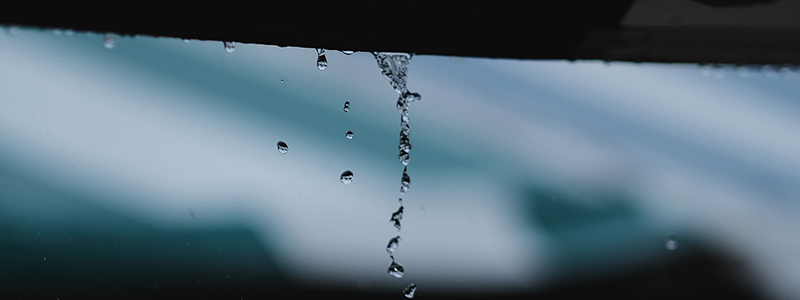
How Long Can You Leave a Leaking Roof?
Is a leaking ceiling an emergency? Almost always yes, but there are two different kinds of emergencies:
- Dangerous or disruptive
- Damaging but habitable
Dangerous or Disruptive
First, is a leaking roof dangerous, and how do you know? If you’re at all uncertain, it’s critical that you leave the house or building immediately and call an expert. Roof collapses and other structural issues can be deadly, so do not take any risks here.
Also, if a leak is disruptive, that’s also a critical emergency. Water pouring onto your bed or TV is an issue that needs to be quickly addressed.
Damaging but Habitable
A leaking roof can wreak havoc on all kinds of things from walls to floors to furniture. It can cause rotting, structural damage, electrical issues, and many other problems that can be extraordinarily expensive to fix.
For that reason, it’s highly recommended to get an expert to look at your leak as soon as possible. If it seems incredibly small and minimal, you might not need to get someone there in the middle of the night, but you’ll want to schedule something first thing in the morning.
Leaking Roof Checklist
When asking “is a leaking roof an emergency,” run through the following checklist to get a better idea of the severity:
- Identify the source of water leakage from roof
- Implement damage control
- Call an expert and schedule inspection
Locate Source of Water Leakage from Roof
If your roof is leaking, the first thing you should do is try to find the source of the leak inside your home or business. Look for puddles on the floor or carpet, dripping water coming from your ceilings, rustic wall stains or moisture in the wall resulting in peeling paint.
Often, if you have an attic – that is the best place to start. Check the insulation in between the floor joists to see if there are any signs of water damage, mold, or stains.
Also, head outside or to a window for a visual inspection. Look above where you can see the leak to try to get an idea of how bad it is. There may be some obvious issues such as broken and missing shingles or a substantial hole. Other times, an untrained eye may not be able to notice anything out of the ordinary. While this may seem like good news, that can make it even more urgent to get an expert out there because damage could be more widespread than you realize.

Damage Control
Soak up any standing water and use buckets or large cooking pots to collect any dripping water. Move anything in your affected room(s) that could be damaged by moisture. Put down drop cloths, garbage bags, or tarps to prevent any further moisture on your floors and carpets. If you are able to safely access your roof, a tarp is a quick and easy temporary solution to prevent further leaking until you’re able to get a professional roofer to assess your leaky roof.
Contact an Expert
Keep in mind that a leaking roof doesn’t necessarily mean you will need to replace the whole thing, so don’t be afraid of the cost when calling an expert.
Even if you believe the situation isn’t severe, you’ll want an expert to have a look as early as possible. Waiting makes things worse, and that leads to a much more expensive repair.
We offer 24/7 emergency roof service in Colorado, so don’t hesitate to contact us for assistance.
Roof Leak Damage Signs
You may be asking “is a leaking roof dangerous,” but you should also be concerned with the signs of a leaking roof. After all, you may have a broken pipe in a wall or some other issue.
Look for some of these signs:
- Water dripping from the ceiling. This is an obvious and strong sign.
- Wet walls. This can be identified by discolored paint, bubbles, or simply a feeling of moisture when you touch the wall.
- If you find water puddled on the floor and can’t identify the source, it’s very likely coming from the ceiling.
- Repeats of any of these symptoms. If you find any of these around different areas of the house or building, that’s a big sign that it’s coming from the roof. It’s also a big sign that it’s urgent to fix because it’s likely causing internal damage that you’re not yet aware of.
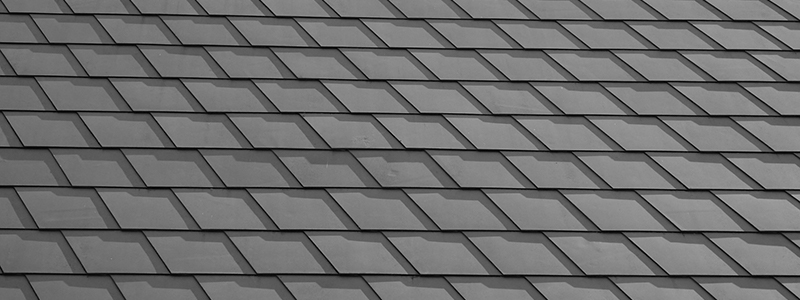
Preventative Maintenance
The best way to not have to get online and ask “is a leaking roof an emergency” is to engage in preventative maintenance. Prevent leaky roofs in the future by regularly maintaining the area around your roof.
Trim any low-hanging tree limbs around your property. These can scrape and damage your roof’s surface and with high winds, loose branches can come off and cause damage.
Make sure your chimney is maintained – smaller roof leaks can be caused by missing or cracked chimney flashing or pipe collars.
Clean your gutters if they are clogged with leaves, dirt or debris. Your gutters act as your roof’s drainage system and they play a significant role in keeping your roof leak-free.
A roofing emergency can cause a lot of headaches, but with the help of a reliable and responsible roofing company, it doesn’t have to be a nightmare. If your roof is leaking, contact a professional roofing company to help. Don’t try to repair the roof on your own – there’s too much risk of injury and a homeowner won’t properly assess the actual damage.
At B&M Roofing, we specialize in commercial and residential roofing repair. No repair project is too large or too small and we are confident in the quality of our service work and the commitment of our craftsmen. Contact B&M Roofing today to get a free estimate.
Most Durable Roofing Material
Colorado has three hundred days of sunshine. While sunshine is very appealing, the blazing heat and UV radiation can wear down even the most durable roofing materials. To combat Colorado’s challenging weather conditions, it is important to choose the most durable roofing material and to ensure it is all expertly installed by a roofing professional knowledgeable about Colorado’s weather challenges. Colorado’s higher altitude, air pressure, solar radiation, density, oxygen, and temperature affect the longevity of your roof.

Most Durable Roofing Material Choices
The following are some of the most durable roofing materials that are recommended by our Colorado roofing specialists:
Asphalt Shingles
The lifespan of asphalt shingles is between fifteen and thirty years. Because of this and their reasonable price, they are a popular roofing choice. To ensure durability, choose shingles with a good hail rating.
Asphalt shingles are also recyclable so they don’t fill landfill sites.
Wooden Shakes
Wooden shingles or shakes last between thirty and fifty years. Wooden shakes are constructed of fire-resistant cedar or redwood. While not as durable as asphalt, they last longer. Wooden shingles are natural insulators so they get extra marks for energy efficiency.
Metal Roofing Materials
Like wooden shakes, metal roofing materials last thirty to fifty years. Most are made of steel, copper, zinc alloy, or aluminum. While a little more expensive than wooden shakes, metal roofs are significantly more durable.
Because they are impact-resistant, metal roofs are a good choice for Colorado’s climate. Metal roofs are also more maintenance-free than many other roofing materials. Metal roofs also act as natural insulators, keeping homes cooler in hot weather and warmer in Colorado winters.
Metal roofing materials are totally recyclable and are made from recycled materials.
Plastic Polymers
Plastic polymer roofing materials have a lifespan of over fifty years. While they look like slate or wooden shingles, polymer roofs are incredibly durable. They are also maintenance-free.
Plastic polymer roofing materials withstand Colorado weather challenges.
Highly energy efficient, plastic polymer manufacturers use recycled materials. Ideal for Colorado’s high rates of sunshine, plastic roofs reflect energy, keeping homes cooler in summer and warmer in winter.
Slate
A slate roof can last between seventy-five and a hundred and fifty years. Slate is the most costly and the most durable of the durable roofing materials. Slate is fireproof. The highest winds and most severe Colorado snowstorms don’t phase slate roofs. However, slate tiles can crack under the weight of snow or ice. It is vital that it be applied by a roofing specialist.
Because slate needs to be replaced so infrequently, it is much better for the environment than many other roofing materials. Slate is also naturally occurring, so no toxins are involved in the manufacturing process. The densest of all roofing materials, slate is also the best insulator.
Solar Glass
If it is properly installed and cared for, solar glass roofing will last a lifetime.
Solar glass roofing comes with a lifetime tile guarantee. It can withstand the challenges of Colorado weather.
Solar glass roofing tiles are highly energy efficient. While relatively expensive to purchase and install, solar glass often comes with a tax credit. Not only is solar glass energy efficient. It generates its own energy. Thus, it is highly sustainable.
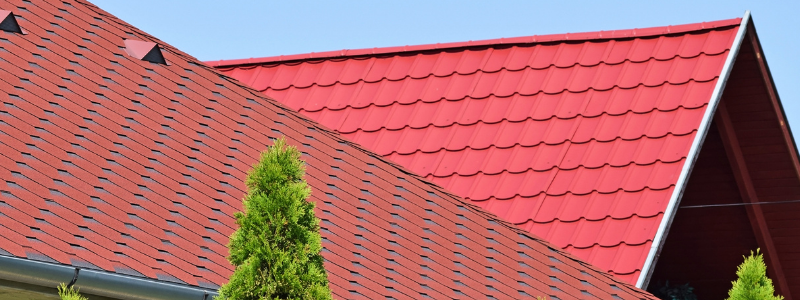
Longevity Trends
There are certain roofing material trends that are taking commercial and residential properties by storm right now.
Metal Roofs
Metal roofs are in demand once again. They are popular because of their visual appeal, versatility, function, and durability. Metal roofs enhance the curb appeal of homes and businesses. Constructed of steel, aluminum, alloy, or copper steel roofs offer a wide variety of textures and shapes. They prevent leaks and repel snow and rain. Their longevity offsets the upfront costs. Metal roofing is some of the most durable roofing material on the market.
Asphalt Shingles
Roofing trends come and go but asphalt shingles remain another most durable roofing material. They are both flexible and affordable. They adapt to almost any weather. Thanks to technology, asphalt shingles are now available in a stunning array of styles and colors.
Roof Aesthetics
Roofs no longer blend into the background. They make a statement about the home and the owner. Homeowners are changing up their roof colors to showcase their homes. Owners choose eye-catching hues like black, gray, silver, or bronze.
Roof Coatings
Silicone roof coating—once a part of commercial buildings—has become popular in residential roofing. This material alters the roof’s appearance in just two coats. Silicone roof coatings also provide longevity as the protective coating offers leak-proofing.
Solar Energy
Solar power lightens the carbon footprint as the roofing materials are energy efficient. Moreover, the newest solar panels are smaller and less expensive. Called photovoltaic shingles these solar panels now mimic the look of traditional roofing materials.
Cool Roofing Materials
Cool roofs are a popular response to environmental issues like global warming. Constructed from energy-reflecting and energy-absorbing materials, cool roofing materials reflect and/or absorb heat in response to weather challenges.
Synthetic Materials
Eco-friendly, synthetic roofing materials are increasing. Created of recyclable materials like rubber and plastic, they can offer options in shapes, sizes, and colors. Synthetic roofing materials are very durable even in Colorado weather conditions. Mimicking slate or wooden shakes, synthetic materials are aesthetically pleasing, durable, relatively inexpensive, lightweight, and easy to install and maintain.
Green Roofing Options
Green roofs offer a way to incorporate beauty and function. Atop businesses and homes, owners have incorporated greenery by adding a rooftop garden, patio, or workspace. These rooftop spaces are very durable and protect your home from weather challenges while at the same time offering natural shade and insulation.
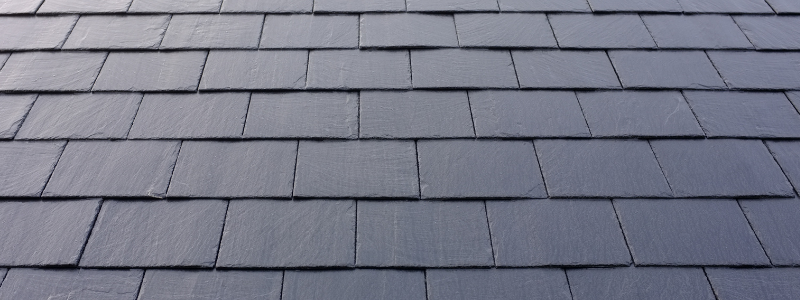
How to Make Your Roof Last Longer
Your roof is an investment in your family’s comfort. Proper maintenance will ensure that it also retains the curb appeal and structural integrity of your asset. Here are some ways to extend the longevity of your roof.
1. Avoid Power Washing
This may seem like a great way to remove grime and debris but it also removes or loosens roofing materials. Use a broom, roof rake, or leaf blower to remove dirt and moss. Better yet, have a professional clean your roof at least twice a year.
2. Check Ventilation
Poor ventilation can cause condensation and rotting wood. Mold and mildew can develop. This is dangerous to the health of your home and its occupants.
3. Keep Gutters Clean
Check gutters at least once a season. Remove debris. This will prevent water buildup and roof leaks.
4. Check Insulation
Insulation helps prevent ice dams and roof leaks. Consider installing a self-adhesive layer to protect against ice and water on your roof.
5. Protect Against Severe Weather
If you live in an area that experiences hurricanes, severe thunderstorms, buzzards, or tornadoes, fortify your roof with seal decking and ring-shank nails. Lock roof edges with metal flashing.
6. Regular Roof Inspections
Have a knowledgeable roofing professional check your roof for damage or debris at least twice a year.
Why Choose B&M Roofing?
Just as it is crucial to select durable roof materials, it is also important to choose a roofing specialist that understands Colorado weather challenges.
B&M Roofing has been a Colorado-owned company since 1947. We provide reliable, meticulous service to thousands of Colorado homes.
Licensed and insured B & M roofing specialists have a proven commitment to excellence.
Curled Shingles
The biggest part of roof maintenance is ensuring all your shingles are properly in place. However, as asphalt shingles age, you might notice their corners start to curl inward or out, which can become a little bit of an eye-sore for homeowners or neighbors passing by.
However, it’s important to note that the impact of curling shingles goes beyond aesthetics. Curled shingles can also result in leaks, structural damage, and mold infestation, creating damages that go beyond your roofing.
If you spot any signs of damage or wear, call B&M Roofing for immediate action. Our roofing professionals will determine which shingles are damaged and need repair.

What Are Curled Shingles?
Curled roof shingles will have raised at the edges of the shingle tab. This can occur at the lower edge or even on two sides of the tab. If the center of the shingle is concave, it is referred to as “cupping”. If the edges of your shingles are raising outwards, it is described as “curling”. Both of these can occur on the same roof.
Remember, for your safety, do not walk on curling shingles. It’s best to have your roof observed by a professional or from a secure ladder.
What Causes Shingles to Curl?
The most common cause of curling shingles can be attributed to turbulent weather and strong winds. Additionally, weather fluctuations can cause shingles to loosen up or shrink, which can lead your roof to look uneven.
Poor attic ventilation can also cause shingles to curl. A poorly ventilated attic will trap moisture from the air in its decking. This excess moisture can cause the shingles above to curl as a result.
Curling shingles might also be a result of a poor installation job. There are specifications that many roofing manufacturers follow. They include the number of nails per shingle and nail length. Failure to adhere to these specifications can cause your shingles to prematurely curl.
Additionally, homes with multiple layered roofs (also known as an overlay) might also be more prone to premature shingle curling, especially if the first roof layer is full of unrepaired damages. In most cases, the second layer of the roof isn’t secure enough and shingles are easily curled or blown by high winds and extreme weather.
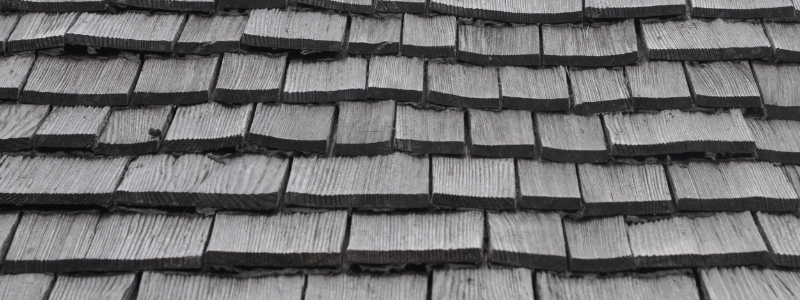
What Damages Can Curled Shingles Have on Your Home?
If shingles aren’t fixed and repaired immediately – water and moisture and seep underneath the shingles, which can rot the wood and foundation of your home. A damaged foundation can lead to leaks, less insulation inside the home and can even promote mold infestations and affect the air quality of your home.
Dry and wet rot fungi can also form as they can be destructive for your home. Dry rot can spread quickly throughout the structure’s fabrics and masonry, causing fundal decay. Wet rot is more localized but can also cause structural damage if left untreated.
To avoid any resulting damage to your home, it’s recommended to have your roof inspected regularly. The cost of repairing a severely damaged roof will be significant, especially if damages and needed repairs are ignored.
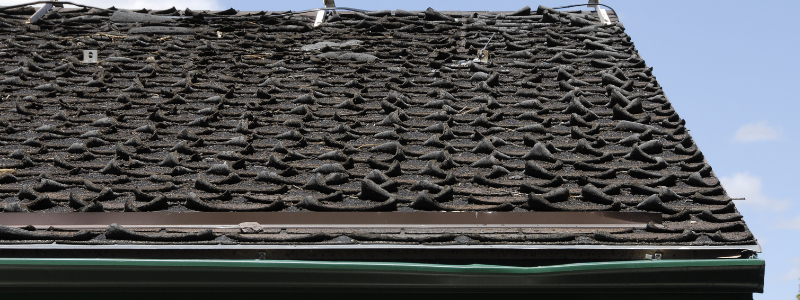
B&M Roofer’s Guarantee
At B&M Roofing, we can inspect your shingles and properly set you up for repair or full replacement. If your roof looks sound but you aren’t sure about its state, call us anyway for an inspection. It’s best to catch small repairs before bigger problems escalate.
B&M Roofing is Colorado’s most trusted roofing repair and replacement company. Our reliable, and experienced team of roofing technicians are skilled with various materials and roof types and can help you execute many types of home improvement projects.
Contact us here or give us a call at (303) 443-5843.
House Roof Types
The roof of your home doesn’t just protect the contents and residents. The shape of the roof plays a significant part in the overall appearance and architectural style of your home.
Some house roof types can even provide additional living space or storage space.
A well-designed and properly maintained roof makes your home more resilient to Colorado’s sometimes-severe weather conditions. The roof can provide increased energy efficiency and weatherproofing. This can also cut home heating and cooling costs.
So what are the most common house roof types in Colorado?
Most Common Colorado House Roof Types
In Colorado, the choice of roof shapes is somewhat dependent on weather. The architectural design that is your personal choice may have to be weighed against what is practical in a state that gets extremes of wind, snow, cold, and heat.
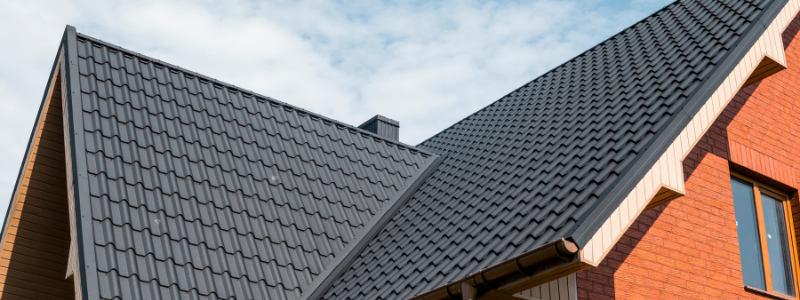
Gable Roof
Gable roofs are often referred to as “inverted V” shapes. Gable roofs slope on two sides: front to back or side to side. There are variations like box gables, open gables, Dutch gables, and gable roofs with dormer windows.
Gable roofs are simple but effective. It is important to get a gable roof pitched just right for Colorado weather conditions.
In Colorado, care must be taken to keep the angle of the slope high enough to allow rain and melting snow to drain off the roof effectively. If the pitch is too low, water lying on the roof may cause damage to the shingles and the underlying structure. However, if the pitch is too high, high winds may damage the shingles and even tear off the roof.

Butterfly Roof
This roof shape has often been called a “reverse gable”. The butterfly design slopes from the outside into the center. This roof type is common with modern, contemporary-looking houses.
Because the pitch is not high, the roof shape offers less wind resistance. However, sloping toward the center causes snow, ice, and rain to collect on the surface.
The fact that this type of roof slopes toward the center makes drainage even more problematic than with a flat roof.

Hip Roof
Hip roofs are popular in Colorado. The sides come together at the top to form a simple ridge. A hip roof has slopes at all four sides of the house.
Pitch is also important with a hip roof. Like gable roofs, the slope on hip roofs must be just the right balance to drain rain and snow but so high that wind resistance is a problem.
Hip roofs are more stable than roof types like gambrel and gable. The inward slope of all four sides makes hip roofs both sturdy and durable.
Given Colorado’s climate, hip roofs are a good choice because they withstand both high wind and heavy snows. The pitch allows snow to easily slide off and avoids standing water.
Dormers or crow’s nests in hip roofs provide extra living space.
The downside is that hip roofs are expensive when compared to gable or A-frame roofs. Their more complex design means more materials and labor so higher costs.
When additional dormers or crow’s nests are added water may collect in seams and cause leaks.
Variations of the hip roof include hip-and-valley roofs, intersecting hip roofs, cross-hip roofs, and pyramid-hip roof shapes.
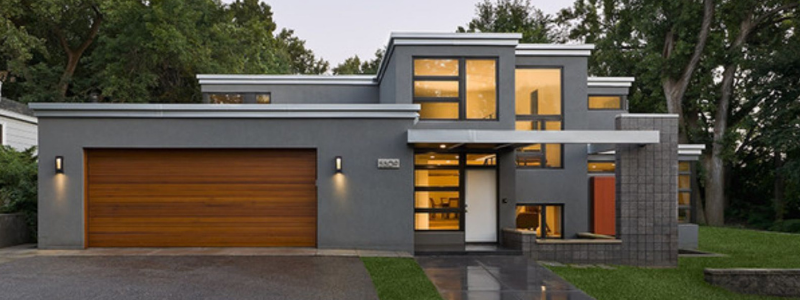
Flat Roof
Flat roofs and butterfly types of roofs are more common in business structures than in house architecture. However, these roof types are becoming more popular in housing developments.
The advantage of a well-designed flat or butterfly roof is that the shape can offer added outdoor living space. You can add a rooftop garden, patio, or partially enclose a penthouse room. HVAC systems can also be placed on a flat roof out of sight. This roof shape works well for wind resistance.
Flat roofs are cheaper and faster to build because they require few materials and less labor.
One disadvantage is that flat roofs present problems with drainage. Snow, ice, and rain collect on the flat surface. For this reason, flat roofs are not recommended for Colorado climates where there is a lot of snow and rain. Low to no slow also causes problems with weight buildup and often results in leakage into the home as it does with butterfly-shaped roofs.
Flat roofs cost less to build but they can be expensive to maintain and repair.
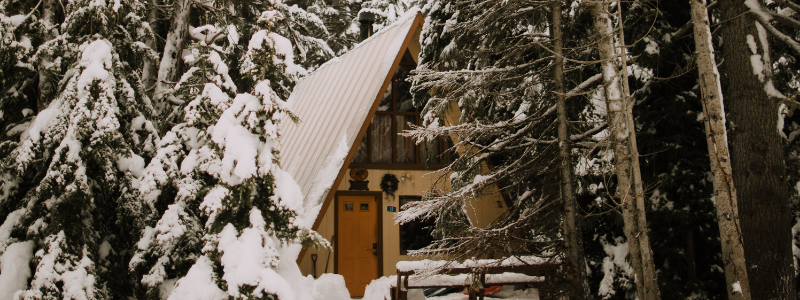
A-Frame Roof
An A-frame roof is easy to identify. It is a steep, pointed, inverted V. The roof goes all the way to the ground, taking up much or all of the house walls. You’ll see this type of house roof in wooded areas, where a lot of snowfall is expected.
A-frame roofs are simple and cheap to build. The A-frame roof doubles as all or part of the home’s sidewalls.
Besides being inexpensive to build, A-frame roofs are pitched so steeply that water and snow do not accumulate.
There are disadvantages, however. A-frame roofs can make the interior of the home dark. The inside walls are sloped. This limits potential space on the second floor. Not every design lends itself to an A-frame type of roof.

Gambrel Roof
A Gambrel roof is often referred to as a barn roof. It has two different slopes. Unlike the mansard roof style with four sides, the gambrel has two sides.
The lower side of the gambrel roof has a steep, almost vertical slope. The gambrel roof style is popular in farmhouses, log cabins, sheds, workshops, and storage buildings.
Advantages of the gambrel style include extra living space. Homes with gambrel roofs often have garrets, attics, or lofts. Gambrel roofs tend to be less expensive than some roof styles because they are quicker and easier to frame. The style uses only two roof beams. Thus, less material is required.
However, there are some disadvantages. The steep pitch makes a gambrel roof not a wise choice for areas where there are high winds and/or heavy snowfall. The roof style is likely to collapse under heavy pressure. If gambrel roofs are not well constructed the ridges can leak. Gambrel roof ridges must be repaired frequently to keep them watertight. Yearly inspections and repair avoid storm damage.
There are several variations of the gambrel-style roof including gazebo-type roofs and mansard roofs. Some gambrel variations are referred to as French-style roofs, “jerkinhead” roofs, and “saltbox” roofs.
Single properties may include several roof types.
Why Choose a Roofing Specialist?
No matter which roof type you choose for your home, the roof requires annual inspection and repair.
Roofing specialists like B&M Roofing have the expertise and experience to deal with the unique needs of every roof style. Regardless of the roof style, it is important to have your home’s roof checked yearly by knowledgeable roof repair specialists.
When your home has been damaged by Colorado’s challenging weather conditions, it is crucial to choose a Colorado roofing company that can restore your roof, the gutters, downspouts, windows, doors, and siding to their original condition.
To discuss which house roof types are best for you and your family, reliable roof repair or replacement, or to request a free estimate for your home, contact us.
How Long Does a Roof Last in Colorado
Colorado weather poses a challenge for roofs. As one forecaster noted, within a single day, areas of Colorado can see rain, snow, high winds, hail, downpours, and beating sun. So, how long does a roof last in Colorado?
There are several factors to consider. Weather is a major consideration.
Colorado has cold and snow during the winter season. This is a challenge for the longevity of your home’s roof. Heavy snow and the build-up of ice pose a challenge for roofs in Colorado. During spring and fall, Colorado often receives heavy rainfall. During these seasons, leaks are not uncommon. In high-wind areas of Colorado, roof materials may be blown off. This can also cause leaks. Colorado has two hundred and fifty or more days of sunshine.
While sunshine is very appealing to people relocating to the state, it is not so healthy for your roof. With Colorado’s high altitude comes the intense sun. This can cause roof materials to crack, blister, melt, and fade. Winds are also a factor. Two things cause Colorado winds. In the winter, the difference between strong low pressure and cold, high-pressure systems produces wind. Chinook winds also develop across mountain ranges. While Colorado winds are good for wind power generation, they can be hard on roofs. Usually, winds between seventy and ninety miles per hour cause roof damage. Even gusts of only fifty miles per hour may also cause damage that requires roof repair.
The lifespan of Colorado roofs is shortened by weather conditions like sub-zero temperatures, blistering heat, hail, heavy snows, torrential rains, and high winds.
Roof Slope Challenges
Flat roofs are stylish, modern, and efficient. However, in Colorado’s snow and cold, they are not necessarily a wise choice. Low-sloped roofs have a reputation for cracking, collapsing under the weight of snow, and leaking in excessive rains.
Higher pitched roofs allow gravity to work in their favor. Snow, rain, and melting ice slide off whereas with lower sloped roofs you need an effective drainage system and a strong building structure to prevent roof damage and leaks.
Range of Roof Life in Colorado
Many things factor into your roof’s lifespan. At B&M Roofing, we estimate a Colorado roof will last between fifteen and thirty years. Manufacturer’s warranties may be anywhere from thirty to fifty years. However, these estimates depend on things like temperature extremes, weather conditions, and maintenance.
The type of roofing material is also a factor. Asphalt shingles, for example, do better in colder climates than in tropical heat.
Clay or concrete tile roofing is very durable and resilient. However, because they are so heavy, they must be installed on very sturdy roof structures. Clay or concrete roofs will last fifty to a hundred years.
The most durable roofing material is slate. It is expected to last a century or more.
Wood shingles have a lifespan of between twenty-five and thirty years if they are properly maintained. However, the roof must be kept free of moss and twigs so moisture is not trapped on the shingles. Fire is also a danger with this type of roof.
Cedar shakes are thicker than shingles. This means they are a good choice for Colorado’s intense heat and harsh cold winter weather. Wood shakes must be maintained to give them a lifespan of thirty-five to forty years.
Metal roofing is very resilient. Most metal roofing is steel or aluminum with a lifespan of fifty years. Copper or zinc roofing will last a century or more.
Why Get a Roof Inspection?
A new roof can prove pretty costly. With regular roof inspections, you can expect your roof to last longer. So, savings are significant.
Roof inspectors look for wear and tear on your roof. They can accurately estimate the life of your roof. They will make recommendations regarding necessary repairs. Certified roof inspectors can identify unsafe areas and roofing that is in poor condition. Roof inspectors will look at both internal and external components of your roof.
Roof Maintenance
Roof maintenance should occur twice a year. Whether it is done by the homeowner or a certified roof maintenance company, roof maintenance will pinpoint small concerns before they become costly to repair or replacement problems.
Some roof maintenance strategies are simple. Others may require a certified roof maintenance service.
- In the spring and fall, do a check from the ground. Look up. Do you see any lifted, curled, or missing shingles? Are there damaged drip edges? Are flashings buckled or missing? Are fasteners damaged or missing? Are any gutters sagging or broken? Do you see piles of granules?
- Cleaning gutters is a job better done by roof maintenance experts. If it isn’t done two or more times a year, water can back up. This can rot fascia.
- Make sure to trim trees. Leave no branches hanging over or touching your roof. Branches can fall in the wind and damage the roof.
- When you do your inspection, look for evidence of moss or algae. Remove roof debris and overhanging branches to keep moss and algae off the roof. Make sure the attic is properly ventilated.
- Check the caulking on the flashings. If it is cracked or pieces are missing, it needs to be re-caulked. Call an expert.
- Do an insulation check in your attic. Good insulation and ventilation in your attic will extend the life of your roof. Insulation prevents the formation of ice dams and reduces moisture on your roof.
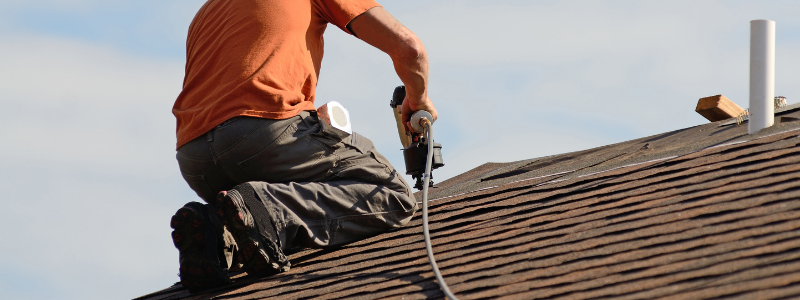
Why Choose B&M Roofing?
When it comes to roof replacement, repair, or maintenance, you want a company that specializes in roofing.
Our Colorado-owned company has recently celebrated seventy years of dedicated service. Our commitment to excellence is evident in every job we do. No roofing project is too big or too small. Each new roof or repair receives our experience and expertise.
Our work extends from commercial projects like the Denver Coliseum and Coors field to residential new constructions and emergency repairs.
B&M Roofing started in Fort Collins in 1947 as a single-truck enterprise. We now provide meticulous service to thousands of customers annually. While we’ve grown bigger, we continue our commitment to total customer satisfaction we vowed to provide seventy years ago.
How to Choose a Roof for your Home
When it’s time to get a new roof, many homeowners wonder which roofing type is ideal for their home. Many consumers explore many roofing types rather than merely replacing their existing roofing systems. While many considerations weigh into the decision, including covenants and personal esthetic preferences, each type of roofing has its own advantages. Don’t know how to choose a roof for your home? Here are some ideas…
Types of Roofing Materials
If you’re wondering how to choose a roof for your home, we’ve included a list of different types of roofs to consider:

Asphalt Roofing
By far the most popular choice for roofing material, asphalt shingles are available in many colors to suit many homeowners’ tastes. We’ve installed our fair share of asphalt shingles and there are a couple of reasons for this:
- They are the most common, with over 75% of American roofs having them.
- They are the least expensive, costing homeowners about $50-$100 per square.
- They are one of the easiest to install, on just about any architectural style.
- They are one of the most affordable of all roofing materials and since they’re easily replaceable, this type of roofing style can cut down your repair costs.
- Asphalt shingles can usually last more than 30 years, depending on the weight of the shingle. These shingles are very fire resistant, as well.
- They can come in a variety of styles, making it easy to select shingles that will complement the style of your home.
However, you might want to consider the downsides to having asphalt shingles as well:
- They have a low R-value (insulation value): Being a thin material, their resistance to heat (and cool) flow is very low.
- They have a shorter lifespan: Compared to other roofing shingles, asphalt shingles don’t last long, lasting from only 15 to 30 years.
- They are not eco-friendly: They have the least-green roofing option to have on your roof and are not recyclable.
Metal Roofing
A more durable solution than traditional shingles, metal roofing systems also offer more leeway for architects’ designs to flourish, making it a favorite among high-end builders, though are typically much more expensive than other options. Lightweight and virtually fireproof, metal roofs withstand extreme weather well.
Homeowners can reasonably expect to get 50-60 years of service life from a metal roof, though that means you may be investing in a roofing system that will be around a lot longer than you’re in the house.
Metal roofs have a very high life expectancy. They’re weather-resistant, and offer especially good protection from high winds and snow. They are also fire-resistant, earning a Class A fire rating, which means it’s the most resistant.
While metal may seem like an odd roof choice, its range of styles and colors make it an excellent option for giving a modern update to older houses and buildings.
They are also remarkably low maintenance and generally come with a 20- to 40-year warranty. Even though the initial costs of a metal roof will be more than traditional materials, the minimal maintenance and low replacement costs will help save money in the long run.
Wood Shakes/Shingles
Many homeowners prefer the more natural look of cedar shakes and shingles for their roof. While more expensive than traditional asphalt shingles, you can expect them to last 30-40 years if maintained well. Cedar shakes and shingles are more resistant to extreme weather and more energy-efficient than asphalt options but are also more costly.
Wood shingles are small, light, and severed on both sides. Wood shakes are generally thicker and are hand-split. The most common wood shingles are cedar, which are longer-lasting and more fire-resistant. Fire-retardant coatings are typical with wood shingles. Take into consideration wood shingles require a steeper roof to get rid of moisture.
Wood shingles are beneficial for the following reasons:
- Natural Beauty – The character of wood shingles blends nicely with the landscape and other surroundings. Its natural color and look enhance your home’s overall curb appeal and over time, the cedar will change to a more old-fashioned, silver color.
- Lightweight – Second to asphalt shingles, wood (cedar) shingles are one of the most lightweight roofing materials, making them easier to repair.
- Insulation – Cedarwood is a natural thermal insulator, keeping your house cool during the summer and lowering the heating bill in the winter.
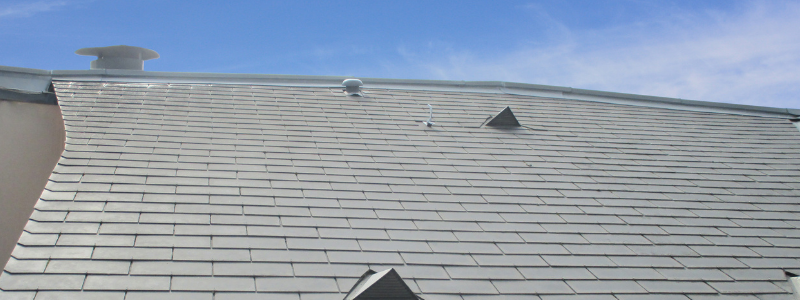 Tile and Slate
Tile and Slate
Homeowners who demand high style often choose tile or slate roofing systems. Concrete or clay tiles are available in numerous styles, from classic Tuscan tiling to fire-resistant concrete replicas of shake roofing.
While many tile and slate roofing systems are engineered to last up to 50 years and are highly resistant to Colorado weather, the roofing underlayment may need to be replaced every 20 years, requiring maintenance many homeowners don’t foresee. Also, because of the weight of these roofing systems, many homes must be structurally reinforced to accommodate them.
Clay Tiles
Clay tiles are all-natural and are fired in a kiln. They are generally one of the most expensive and heaviest of roofing materials. Clay tiles will last a long time, however, as they are environmentally friendly and are resistant to both freezing and hot temperatures, as well as the sun’s harmful UV rays.
However, they are more vulnerable to cracking in Colorado’s extremely low temperatures. There are some benefits, though, like:
- Insulation – Since hot and cold temperatures don’t affect clay tiles as much as other roofing materials, clay is a natural insulator, keeping the energy bill low.
- Low-maintenance – Clay tiles don’t absorb water, mold, or mildew very well, making them basically maintenance-free.
- Color – Clay tiles don’t lose their color much since they are a natural roofing material.
Slate Tiles
Slate tiles are natural, shingle-like, flat sheets of rock. Slate tiles can also be very pricey and heavy for your roof, but the stone look provides plenty of curb appeal to your home. Because of their weight, slate tiles do require extra roof support and framing.
This roofing material requires professional installation, as walking on these tiles can be difficult and result in breaking the stone slates.
In Colorado, these are the most common roofing options we’ve seen in our experience. We can also assist you in how to choose a roof for your home and what it consists of.
If you’re still wondering how to choose a roof for your home, our roofing experts can talk with you about your ideas, your budget, and your needs.
New Year’s Resolutions for Your Roof
With 2021 right around the corner, you’re likely thinking about self-improvement. While we’ll always support your efforts to eat better or read more books, we’d really love to see you make a resolution to treat your roof right. Trust us: It’ll be easier to stick to this one than it will be to quit snacking right before bedtime.
Make the new year the one you start keeping an eye on your roof, and it’ll also become the year you spend less on repairs and other maintenance. What homeowner doesn’t want to see that? Here’s our four-point approach to make your roof’s new year as great as possible.
Get Out the Ladder: If you’re comfortable using a ladder to get on your roof, make inspections a part of your annual maintenance schedule. Many small problems can’t be seen from the ground, and so you’ll need to spot them with a thorough, close-up inspection.
Mind The Landscaping: Roofing is intended to protect your home from the weather, not repel trees. Keep branches trimmed away from your roof each spring and fall, and prevent damage. Similarly, make the effort to clean your gutters and downspouts of leaves and other debris every fall to ensure proper drainage.
Know Your Roof: Every roof eventually needs to be replaced. Do you know your roof’s expected lifespan? Stay in front of repairs – and the damages to your home that can be caused by a failing roof – by knowing when it’s time to start planning for a new roof.
Don’t Be a Fair-Weather Friend: Of course your roof is going to function great on those beautiful Colorado June afternoons. It’s when the weather isn’t so accommodating that issues start to show. Pull out your umbrella and – safely from the ground – take a look at how water drains. If you notice pooling, strange drainage patterns or backups in your gutters, it’s a good sign you need to wait until the weather clears and address issues before they turn into leaks.
As far as resolutions go, pledging to pay better attention to your roof in 2021 is about as easy as it gets: Schedule a couple of hours a few weekends a year, and you’ll be in a great spot to extend your roof’s lifespan and prevent costly repairs.
Buying A House With A 20-Year-Old Roof
A roof is a home’s most important facet. Without a roof – or, without a good roof – everything in that home is susceptible to rain, snow, intense wind, strong heat, UV rays, and so much more. But, with a roof – a good, new one, in particular – your home is completely protected, ensuring that you and your loved ones are safe and that everything you own is completely protected.
Because of this, when searching for a new home, it is so important that you pay close attention to the age and wear of the roof of each house that you look at.
Buying a house with a 20-year-old roof means that, in the near future, you may be facing roof repairs or a roof replacement.
Inspect The Roof Before Purchasing The House
Just about every house that you find for sale will have some wear and tear. But, there are some houses that have older roofs – twenty years old, for instance – and these roofs have seen a lot more wear and tear than the roofs on other houses. Making sure that the roof of your new home is in decent shape, while also determining whether repairs are necessary for the near future, is extremely important. To accomplish both tasks in as little time as possible, having the roof inspected before you purchase the house is the best choice.

Your Budget Should Account for Roof Repairs
Even if you feel confident in the house that you’ve chosen to buy, if the roof is very old, then an inspection is a necessity. By purchasing the house, without having the roof inspected, it’s likely that a series of unforeseen issues may arise, most of which will be due to the roof’s age. But, if you have the roof inspected before you purchase the house, you can determine the condition of that roof, whether repairs are necessary and, if so, what those repairs are and when they should take place.
By doing an inspection before purchase, you can add into account the cost of roof repairs when you make an offer on the house.
A professional roof inspection consists of inspecting the roof’s exterior and, then, the roof’s interior. The roof exterior inspection consists of going onto the roof and examining the condition of the roof shingles, flashing, and chimney. The roof interior inspection consists of going into the attic and checking the insulation and ventilation, while also checking for leaks and mold. Right after the inspection is complete, you will learn the condition of the roof, any issues that are present, and what needs to be done to fix those particular issues.
What Should You Look For In An Old Roof And When Should You Walk Away?
As you look for your new home, there are a few attributes of each house’s roof that you must look for and take note of. Each one of these attributes will greatly affect the quality and condition of the roof, and those will, in turn, affect your experience living in your new home. By paying attention to these attributes, you will be able to know when to purchase a house and when you should walk away.
Every roof will be a little different. But, regardless of those general differences, there are a few attributes to look for in every roof that you check. These attributes will affect the quality and condition of the roof, as well as your experience in that house, tremendously.
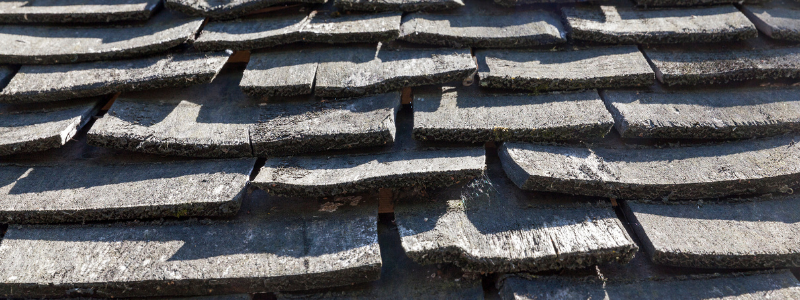
Worn or Missing Shingles
No matter what the house looks like, if you notice that there are missing shingles along the roof, large spaces where moss is growing over the shingles, sagging, or stains along with the ceiling and interior walls, you should walk away.
Each one of those problems can be dealt with. But, more often than not, the cost of repairing those problems is significant and, in the end, not worth the money, when buying a house with a 20-year-old roof.
Depending on the significance of those problems, you may end up having to replace the roof in its entirety, before you’re even able to enjoy the comfort of the home.
Your Homeowners Insurance Policy
Even though home insurance will cover – depending on the policy – roof repairs and replacements, there are a lot of home insurance policies that won’t cover roofs over twenty years old. Most of these policies work in one of two ways; they either won’t write a new policy for a roof that is over twenty years old or, for you to keep your old policy, they require the twenty-year-old roof to be replaced.
The attributes mentioned earlier are what to look for so that you know when to walk away. But, there are a few attributes to look for that indicate the roof you are looking at, even though it is old, remains strong and sturdy. These attributes include things like all of the shingles being present, the roof being perfectly even, clean and sturdy gutters; among various other things.
If you notice these attributes, then that’s a great sign, as it means the roof has been well-taken care of and should last for a while. But, that doesn’t necessarily mean repairs won’t be necessary, either now or in the relatively near future.
The Lifespan Of A Typical Residential Roof
A typical residential roof is meant to last for a specific period of time. But, this specific period of time varies from roof-to-roof, depending on the materials that the residential roof is made of. Being aware of the lifespan that certain roofs offer makes it easy to determine when your new house’s roof – or any roof, for that matter – will need to be replaced.
Every residential roof is meant to last for a certain amount of time. The exact amount of time that a particular residential roof is meant to last for depends entirely on the materials it is made of. Because of this, there are some roofs that can easily last for thirty years, and some that will fall apart long before that.
When buying a house with a 20-year-old roof, take into consideration what materials make up the roof of your potential new home.
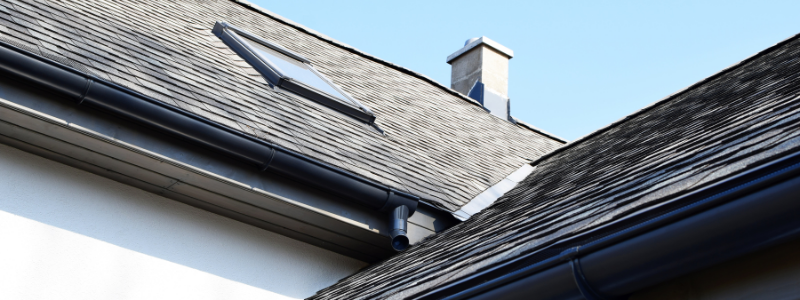
Asphalt Shingle Roofs
Most residential roofs make use of asphalt shingles. The reasons for this are quite simple: asphalt shingles are very affordable, and they often come with good warranties. More often than not, an asphalt shingle residential roof is meant to last for fifteen-to-thirty years. But architectural shingles, which are, essentially, enhanced asphalt shingles, can last for twenty-five-to-thirty years.
Other Material Roofs
Some of the more long-lasting materials are tile, slate, and copper. Roofs that make use of those materials can easily last for up to fifty years. Many other metal materials can last for fifty years, or a lot longer, depending on their overall quality.
If it’s asphalt shingles, you should expect a complete roof replacement. If it’s slate, metal, or other materials, you may have some extra time before a replacement is needed, but repairs may still be necessary.
B&M Roof Inspections
Regardless of the material that your residential roof is made of, though, B&M Roofing is here to help. By contacting us today, you can organize an inspection. Even before buying a house with a 20-year-old roof.
During this inspection, we will consider any flaws that your new home’s roof possesses, then we will tell you the repairs that are necessary, and perform those repairs. That way, no matter what it’s made of or how old it is, your roof will be in tip-top shape.
How to Stop a Roof Leak Temporarily
It’s a homeowner’s nightmare – watching water leak through your roof, damaging your home while you wait for an emergency roof repair. While B&M Roofing of Colorado offers emergency roof service requests you’ll still need to deal with leaks while you wait for our crews to arrive. Take measures to reduce structural damage while you wait. Learn how to stop a roof leak temporarily, until more permanent repairs can be done to your roof.
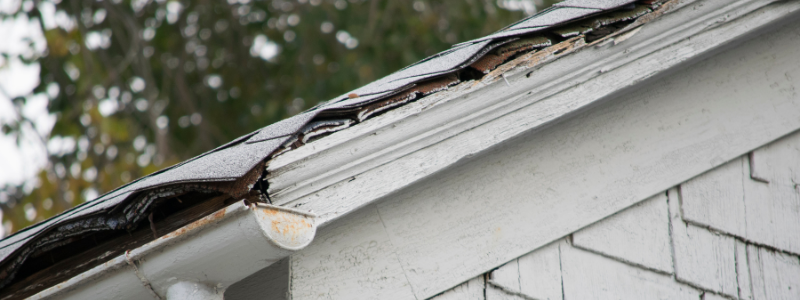
Common Signs of a Leaky Roof
So how do you know what to look for? There are a few signs that you have a leaky roof that will need repairs.
- Gutters are clogged – If you have debris that is clogging your gutters, the water isn’t draining properly as designed, and could be leaking into your roof. When looking at your gutters, look to see where water is dammed or building up. You could have some roof damage around those areas.
- Vent boots are damaged or worn – Also known as vent pipe covers, vent boots are the rubber or plastic cover around your vent pipe that seals off the pipe around the area that it touches the roof. If that area is compromised, water is probably getting past your roof, causing damage.
- Loose flashing – flashing refers to the metal strips around the edges or that connect sections of your roof. Look to see if they are loose or if there are any gaps between the roof and the flashing. If so, chances are you could have water leaking between the flashing and the roof. You can do some quick repairs with some caulking in these areas.
These are just some of the most common areas to look for signs of roof leaks, but there are more tell-tale signs of a leaky roof with missing shingles, mold or mildew, signs of rotted wood, and discoloring on the ceiling side of your home.
Leaking Ceiling Repair
Everyone knows water flows downhill, and in many cases, that lowest point is above the ceiling. To allow drainage and minimize water damage above the ceiling, locate the wettest point in the roof – which may be a bulge if the leak has gone unattended for a while – and puncture it with a finish nail or another small item.
This opening allows water to drain out of your attic and into a bucket and is much easier to repair than replacing an extensively water-damaged ceiling.
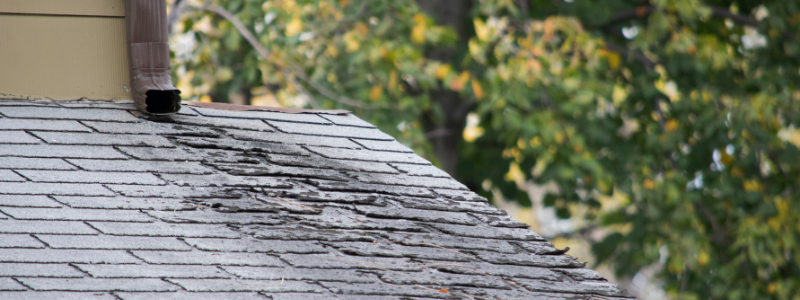
Locating the Leak
The hardest part of fixing a leaky roof? Finding where the leak is actually coming from. Once you locate where the leak is coming from, then it’s easier to know how to stop the roof from leaking temporarily.
If you’re comfortable entering your attic, inspect your roof deck (the roof’s underside) to locate the source of the leak. In many cases, leaks will spring at joints between plywood, and may not be directly above the leak, or directly below the leak in your roofing.
If the leak isn’t visible, there’s a way you can spot where the leak is coming from (being very careful, of course).
Water can enter your roof in one place and run down to another place before you start to notice it, or before it starts soaking into your ceiling. Obviously, you’ll want to find the leak in your roof before the entire roof and ceiling go bad, so the best way to look for a leak is when there’s water running.

You won’t want to wait to check for leaks when a heavy rainstorm hits your house and does significant water damage. Instead, control the amount of water flow by taking a garden hose up onto the roof. DON’T GO CRAZY HERE, you don’t need a large amount of water to find the leak.
Run the (small amount of) water over different places where you think the leak(s) might be. Have someone else be in the attic looking for moisture with a flashlight. The water will reflect the light and make it easier to see.
Don’t have an attic? Check for other clues of where leakage might be coming from by pouring a small amount of water through:
- Flashing
- Ridge caps
- Roof valleys
- Gutters and downspouts
If it’s feasible, make sure to collect any water dripping from the roof in your attic (or anywhere else) with a bucket, eliminating any opportunity for it to do additional damage to your home.
Patching a leak from the underside of the roof deck with tar, shingles or plywood isn’t a permanent solution. Once water is getting past your roofing, you’ll need to address it immediately to avoid additional damage to your home.
We understand how imperative it is to fix a leaking roof, so B&M Roofing of Colorado provides emergency response teams to address leaking roofs. Call us at 303.443.5843 or visit our emergency service request form.
Assessing Wind Damage To Asphalt Roof Shingles
It’s no secret that Colorado, especially in the Winter and Spring, can be a very windy place. Unfortunately, where there’s wind there’s often wind damage. Many homes and businesses in Colorado use asphalt roof shingles, and while asphalt roof shingles look very pretty and tend to be quite durable, they are vulnerable to strong winds.
Since Colorado experiences strong winds on a regular basis, it’s important to be familiar with the effects of wind damage. Assessing wind damage to asphalt roof shingles is essential in keeping your roof protected during Colorado’s nasty storms. The earlier you spot the damage, the easier and faster the repairs will be.
What Are The Effects Of Wind Damage On Asphalt Roof Shingles?
These days, asphalt roof shingles are some of the most popular roof shingles available. It isn’t difficult to figure out why, since asphalt roof shingles look pretty, while also being super affordable and very durable. But, even though asphalt roof shingles are quite durable, they are vulnerable to wind damage and, if they experience strong winds on a regular basis, they can begin to break down.
Today, asphalt roof shingles are some of the most popular roof shingles available. While they may not last as long – fifteen to thirty years, more or less – like other kinds of shingles – wooden shingles, for example – they offer significant durability and affordability.
Even though asphalt roof shingles are quite durable, though, strong winds can damage them with relative ease. When strong winds are present, asphalt roof shingles often suffer from a few different kinds of wind damage.
Bent Roof Shingles
As large gusts of wind move across a roof, the asphalt roof shingles will be pushed and prodded in various directions. Sometimes, depending on the intensity of the wind, the strong winds don’t do much of anything. More often than not, though, the strong winds cause the asphalt roof shingles to bend or detach, if only slightly, from the roof.
Asphalt roof shingles should never be bent since this causes them to break down and become weaker and weaker. But, if they’re only bent once or twice, due to infrequent wind, then there often isn’t much of a problem. If they are bent more than once, though, on a relatively frequent basis – for example, every other day during the Winter or Spring season in Colorado – then the asphalt roof shingles will begin to break down much quicker than they normally would. This shortens their lifespan while also lessening their ability to break the interior of your home from things like rain and snow.
Detached Roof Shingles
Every asphalt roof shingle serves an important purpose, and this important purpose is that of keeping the interior of your home protected from the elements. If one of the asphalt roof shingles is missing, it isn’t good, but it doesn’t mean that your home is completely unprotected. If multiple asphalt roof shingles have become completely detached from the roof, due to strong winds, then certain parts of your roof are completely unprotected.
Even if none of those asphalt roof shingles are completely detached, this doesn’t mean they won’t be. When strong winds move across asphalt roof shingles, causing them to detach just slightly from the roof, the bond between the roof and the asphalt roof shingle is broken down. As a result of this, it’s easier for wind, snow, and rain to seep into the roof, while also being easier for the asphalt roof shingle to fly off of your roof entirely.
- Asphalt roof shingles are incredibly popular due to their aesthetic beauty, affordability, and durability
- Despite being quite durable, though, they can easily suffer from strong winds and experience significant wind damage
- As strong winds move across asphalt roof shingles, they often push and prod those shingles
- By pushing and prodding those shingles, it can cause them to bend or detach from the roof
- If the shingles bend, this causes them to begin breaking down
- If they continue to bend, due to frequent bouts of strong wind, they break down even further until they are no longer able to protect the interior of your home
- Strong wind can easily cause asphalt roof shingles to detach from the roof
- If they detach from the roof only slightly, they are no longer fully bonded to the roof, allowing rain, wind, and snow to seep into your home
- If they are completely detached from the roof, then the roof is unprotected
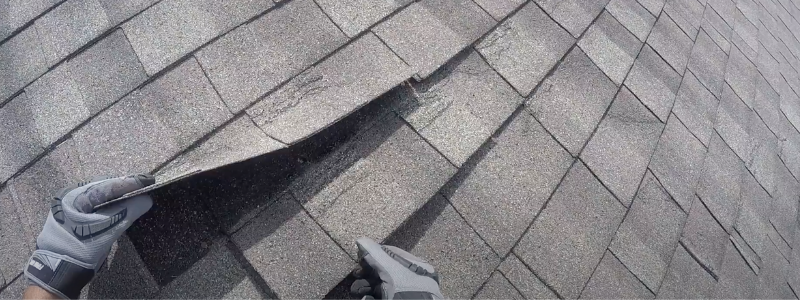
How Can You Assess The Wind Damage That Asphalt Roof Shingles Have Experienced?
Assessing the wind damage that asphalt roof shingles have experienced isn’t always easy, especially since the effects of wind damage aren’t always very noticeable. If you go onto your roof and assess the asphalt roof shingles carefully, while looking for a few key things, it shouldn’t be too hard to assess whether or not your asphalt roof shingles have been damaged by the wind.
Assessing the wind damage that asphalt roof shingles have experienced can be a challenging task. Most of this is due to the fact that the effects of wind damage aren’t always noticeable – noticing a slightly detached roof shingle is harder than it sounds, for example. But, there are a few key things to look for. If you notice these things, then there’s a good chance that your asphalt roof shingle has suffered from wind damage.
Look for Debris
The first thing to look for is debris. If there is any debris on any of the asphalt roof shingles along your roof, then take note of that debris. Most of the time, this debris will be quite small, so it shouldn’t have had a significant effect. But, if it’s a larger piece of debris – a big tree branch, for example – then make sure to inspect the roof shingle. If the shingle has been bent, detached, or crushed, then that asphalt roof shingle must be replaced.
Look for Damaged Roof Shingles
The second thing to look out for is any asphalt roof shingle that has a crease on it. If an asphalt roof shingle has been pushed off of the roof, if only slightly, and bent, then there’s a good chance it has pushed against another shingle. When this happens, a crease is left behind, and this crease usually looks like a slightly messy line or scratch across the shingle. If you notice a crease, then check to see if the creased shingle is loose at all. If it isn’t, check the shingles to the sides, because those may have bent and then scratched the creased shingle.
Look for Detached Roof Shingles
The third and final thing to look out for is any asphalt roof shingle that appears slightly detached from the roof. If an asphalt roof shingle doesn’t appear to be lined up with the shingle behind or in front of it, then that’s a sign that it’s been detached from the roof. By inspecting that shingle, you will be able to determine whether or not it has been detached, if only slightly, from the roof.
Trust the Experts in Wind Damage Roof Repair
If you just aren’t sure what to look for or how to look for it, then there’s no need to worry. At B&M Roofing, we offer a free inspection. By hiring us, we will look at your roof and determine whether or not any wind damage has taken place. From that, we will begin formulating a plan on how to fix that wind damage in the best and most affordable way possible!
- Assessing the effects of wind damage to asphalt roof shingles can be difficult
- If you take the time to look for three key things, though, then it’s usually much easier to notice and assess the wind damage that has taken place
- If there is any debris on the asphalt roof shingles, inspect the shingle and make sure it hasn’t been bent, crushed, or detached
- For bent shingles, notice if any shingles have a crease running across them,
- If they do, inspect the shingle and the shingles around them to see if any of them are slightly detached or bent
- Take the time to look for any asphalt roof shingles that look slightly detached
- If they look slightly detached, there’s a good chance that the wind has weakened the bonding between them and the roof
- At B&M Roofing, we offer a free estimate that will help you assess the wind damage to your asphalt roof shingles while formulating a plan for safe and affordable repairs


